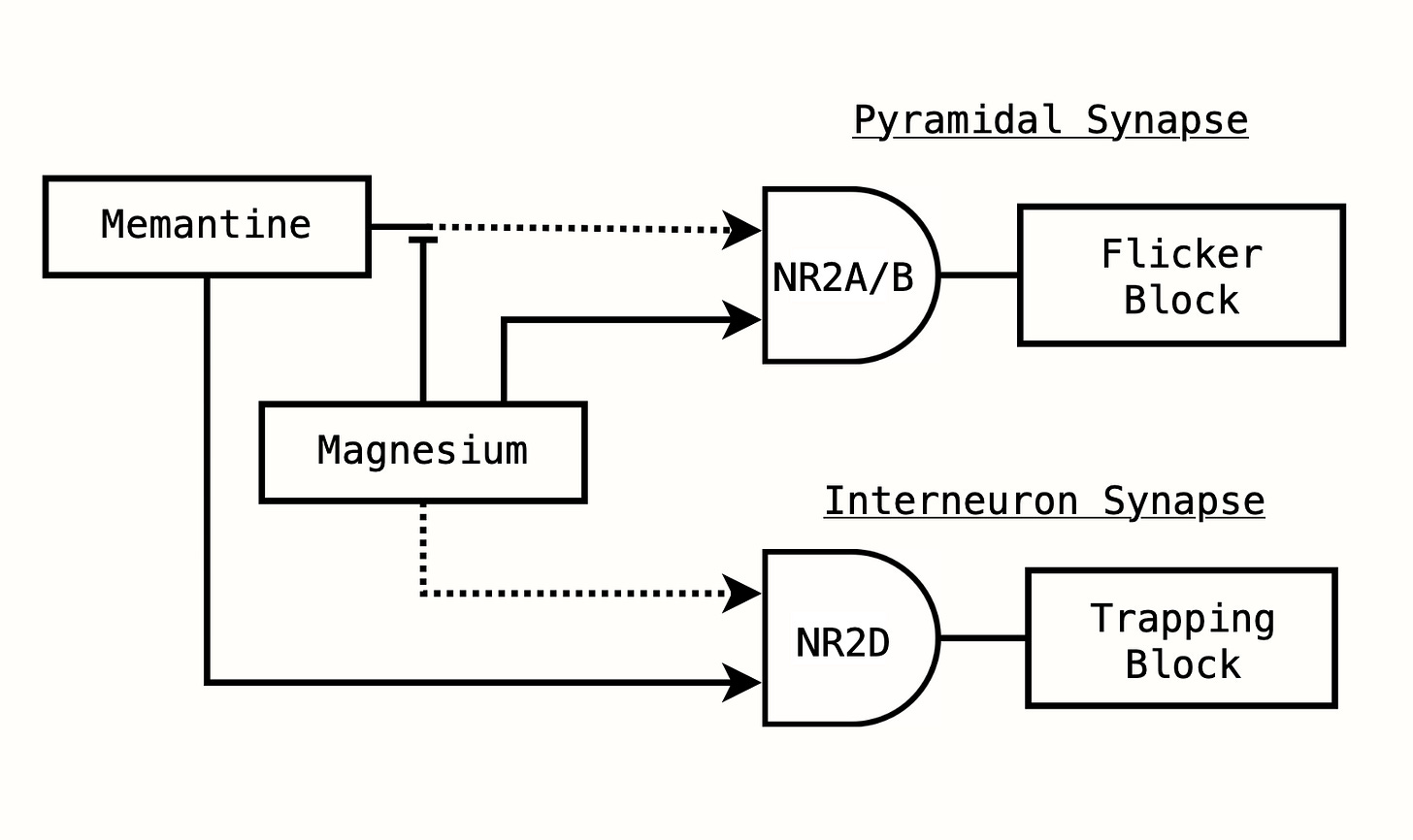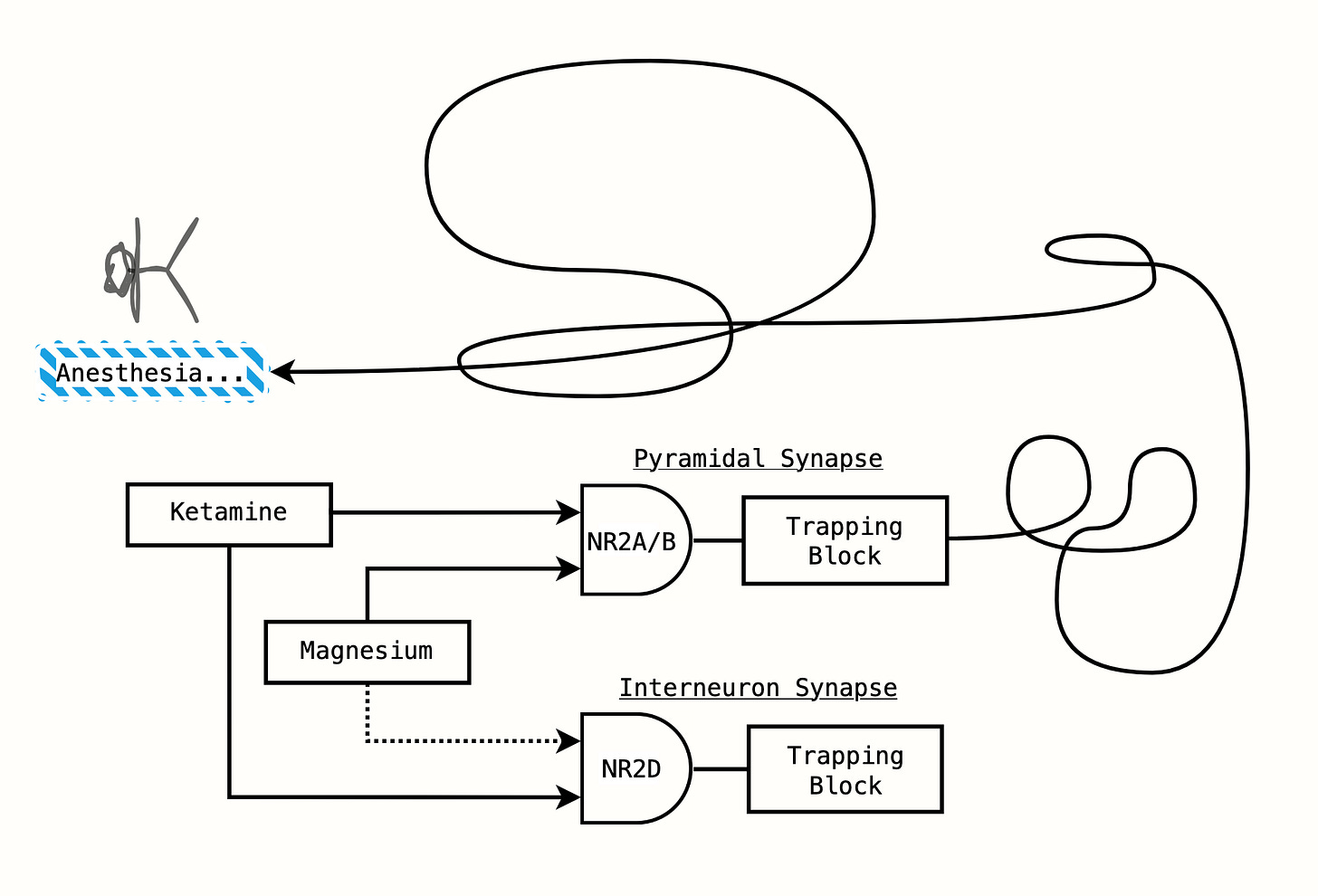NMDA Receptor Antagonists: Slightly More than you Wanted to Know
Insights from comparing Memantine and Ketamine on the function of the NMDA Receptor
Long time no post! I got hired to do some writing and editing for a nootropics startup, but i’m finally back! I’m sticking to my theme of writing about the NMDA Receptor, this time explaining why NMDAR Antagonists can anesthetize you, treat your alzheimers, or temporarily cure your depression1
A Brief Technical Image
The process of teasing out functions of the NMDA Receptor feels a lot like progressing through this “flowchart” (I ask that you ignore the logic of the image, just scan the vibe2). Using drugs with this protein complex seems to inherently lead to bizarre phenomena on both the level of the neuron (see; Hebbia, Homeostatica, and Magnesia) and the brain as a whole (see; Elon’s twitter feed). This is evident once you internalize that without NMDA Receptors, you fundamentally could not make self-referential memories, much less exist as a viable organism.
Quandaries
When you start taking two NMDA Receptor antagonists at once, medical wisdom dictates that you’re liable to check into a psych ward within the week. This is wrong… but I can’t really call the thought process itself irrational. After all, most doctors encounter these drugs in the context of, “there’s an ER patient going fucking insane off PCP (an NMDAR antagonist).”
They often forget how they treat the incoming patient, “we’ve got to sedate him! Lets use Ketamine (another NMDAR antagonist).” And this works.
Now, both PCP and Ketamine are dissociative anesthetics, so the first thought is that this is probably just a dose mediated effect. Surely overdosing them on PCP would also work as a chemical restraint… Phencyclidine was used as an anesthetic in the 1950s, but those same side-effects that led to its recreational use still occurred when people woke up from anesthetic doses. People on Ketamine wake up and get confused, but they don’t get violent.
The question here is Why? Why does the category of ‘NMDA Receptor antagonist’ mean nothing!
Microlevel Differences
Subunit Selectivity
The most important factor in determining the effects of a given NMDAR antagonist is the drug’s subunit selectivity. The NMDA Receptor is “heteromeric tetramer.” It is composed of four complexes, two of which are NR1 subunits, these are the obligatory units of the receptor and are responsible for its most basic properties.
The other two subuits are free to be composed of NR2A/B/C/D or NR3/A/B. The NR3 subunits can be discarded for our purposes because their mere presence causes the NMDAR to function as a completely different receptor (saving that for another post). Really briefly, this is what you need to know about the NMDA Receptor (I do this every post):
It has a pore that lets Calcium ions flow through
This pore is nearly always plugged up with Magnesium
To open the pore, the Magnesium needs to leave, Glycine needs to bind to NR1, and Glutamate needs to bind to NR2
The role of the NR2 subunits is to bind Glutamate and to modify the properties of the receptor as a whole. Even among NR2 subunits there is heterogeneity; NR2A/B subunits have a codependent relationship with Magnesium, NR2C/D subunits… they can do without. This means that NR2C/D subunits let a lot more current into the cells (see; prior blog).

Trapping and Flickering
The second most important factor is how these drugs are unbinding from the NMDA Receptor. For instance, Ketamine is anesthetic because at high doses it never comes unbound, whereas Memantine dissociates from the receptor every single time the central pore opens. For this reason Ketamine is referred to as a ‘trapping’ antagonist whereas Memantine flickers in and out of the central pore.
The capacity for an NMDAR antagonist to trap the receptor is determined by how it interacts with the central pore; specifically, whether or not Magnesium occludes it from binding. Memantine is occcluded in such a way but when you add a +2 charge to it (chemistry is strange) it will displace Magnesium and become a trapping antagonist… Weird!
NR2D subunits are uniquely easy to trap because antagonist binding is predicated on the receptor’s affinity Magnesium, of which, the NR2D subunit has very little. This phenomenon leads to a network state called disinhibition (not behavioral disinhibition, thats a whole other thing). Nearly all NMDAR Antagonists produce disinhibition because they trap NR2D first (even without preferential binding) and trap the other subunits after reaching a certain dose threshold.
Excitatory or Inhibitory Targets
The final factor that i’ll speak of, is what type of neurons the drug binds to.3 This is important because where the drug binds changes the behavior of the whole network. NMDA Receptors are found on all types of neurons4, but the composition of te NMDA Receptor differs based on the type of neuron it’s expressed on.
This ties in very nicely with Subunit Selectivity and the Trapping/Flickering dichotomy. As previously mentioned, due to the NR2D-subunit NMDARs having really weak Magnesium block, this means that Memantine can become a trapping antagonist as opposed to a flickering antagonist on this type of NMDA Receptor. It just so happens that NMDA Receptors containing the NR2D subunit are expressed almost exclusively upon inhibitory interneurons.

Ketamine is a slightly different case…

Conclusion
You may have noticed in the flowcharts that the three factors; Subunit Selectivity, Trapping and Flickering, and Excitatory vs Inhibitory Targeting… all seem to overlap/correlate with one another. That is, a drug targetting NR2D subunits would also tend to target location on inibitory neurons and high trapping (ceteris paribus of course). This is mainly because (for all NMDAR pore antagonists) ‘Subunit Selectivity’ is almost entirely predicated upon the presence of a Magnesium ion in the central pore (see; Kotermanski & Jonson and prior blog et. al).
There are some NMDA Receptors immune to the sort of heuristic I have here, these are mainly NR2C-containing receptors on the surface of glial cells, they aren’t as engaged in conventional signalling like evoked or spontaneous EPSCs (see; prior-prior blog et.al), but their role in homeostasis is important; just too complicated for an already convoluted post. As for how NMDAR Antagonists interact with them, they are targetted by Memantine and they do get trapped by it, they just don’t factor into the dissociative/disinhibited signalling as much due to their location.
Final Thoughts
Going back to the quandaries, I got into the literature on this because couldn’t figure out/predict what sort of state a given NMDAR Antagonist would produce. PCP was easy, I knew about its recreational use as ‘Angel Dust’ and its activation of the Dopamine D2 Receptor (super interesting receptor btw) and it was pretty easy to go from there. Memantine was quite different, it had an off-target effect on the α7-Nicotinic Acetylcholine Receptor (nAchR) but this was irrelevant for diffrentiating it from ketamine. I call it irrelevant because ketamine *anesthetizes you* and no amount of modulating the α7-nAchR will prevent that.
Next blog, I will probably take a break from NMDA Receptor-Mediated Neurotransmission. Despite how cool it is, attempting to understand it requires too much brain power for a Dance Major. Unfortunately, I am drawn to the convoluted so… I’ll probably get sucked into the α7-nAchR or D2 receptor literature.
(for 10-14 days)
stole this language from a carly busta essay
there are more factors, they just tend to overlap with the facotrs mentioned here
if you disagree you’re a pedant




